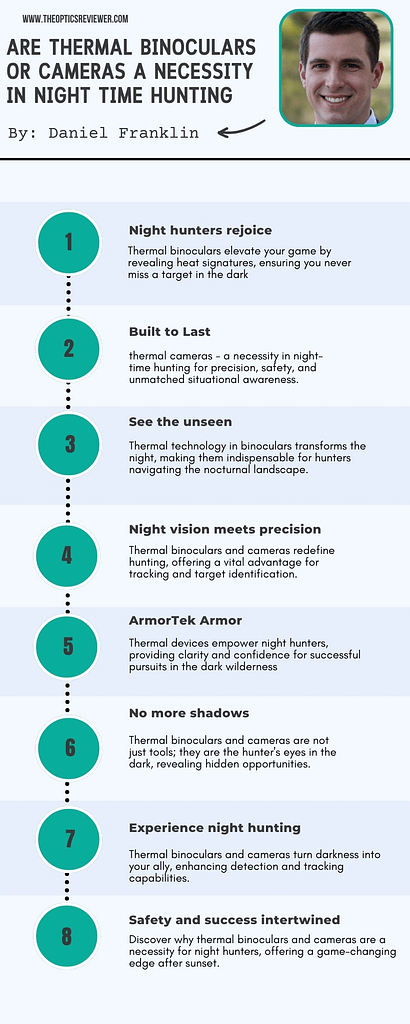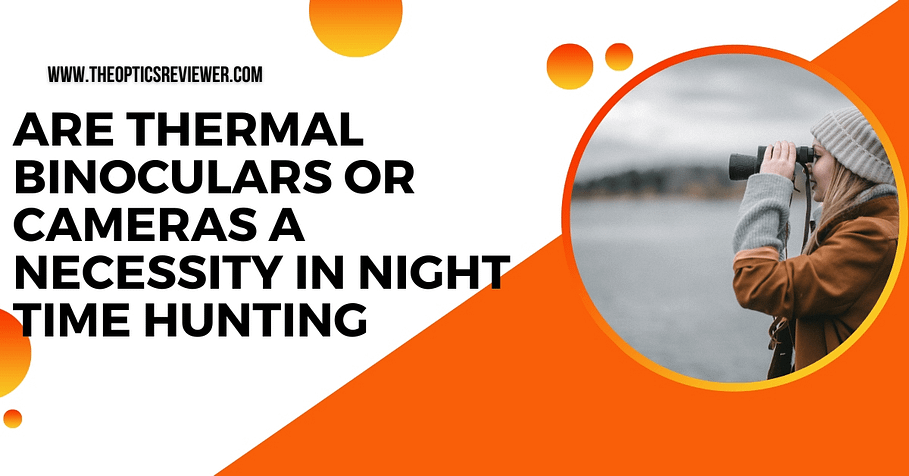In the realm of nocturnal pursuits, the inky darkness of night serves as both a veil and a challenge for hunters. In the quest for elusive prey under the shroud of moonlight, the pivotal question arises: Are thermal binoculars or cameras a necessity in night-time hunting? As the stars cast a faint glow on the wilderness, the answer unfolds in the form of cutting-edge technology. Thermal binoculars and cameras emerge as the beacon guiding hunters through the obsidian canvas of the night.
In this captivating exploration, we delve into the crucial role these thermal marvels play in the hunt after dusk. From unraveling the secrets of heat signatures to providing a tactical advantage in the shadows, these devices redefine the landscape of night-time hunting. Join us as we embark on a journey to unveil whether thermal binoculars or cameras are not just a luxury but indeed an essential companion for those who dare to venture where the nocturnal mysteries unfold.
Contents
- 1 Key Takeaways
- 2 What are the Thermal Binoculars For Night Hunting?
- 3 Are Thermal Binoculars or Cameras a Necessity in Night Time Hunting?
- 4 What are the Differences Between Night Vision And Thermal Binoculars?
- 5 What are the Main Applications of Night Vision And Thermal Binoculars?
- 6 What are the Legal Restrictions on Using Thermal Binoculars or Cameras in Night Time Hunting?
- 7 What are the Pros And Cons of Thermal Binoculars?
- 8 Conclusion
- 9 References
- 10 FAQs
Key Takeaways
- Thermal binoculars and cameras enhance visibility in low-light conditions, providing a crucial advantage for night-time hunting.
- These devices enable hunters to detect and track heat signatures, making it easier to identify and locate animals in the dark.
- Improved situational awareness and target identification through thermal technology contribute to safer and more efficient night-time hunting experiences.
- While not an absolute necessity, thermal binoculars or cameras can significantly increase the success rate and overall effectiveness of night-time hunting activities.
What are the Thermal Binoculars For Night Hunting?
Thermal binoculars for night hunting represent a groundbreaking fusion of technology and outdoor pursuit, offering hunters an unparalleled advantage in navigating the darkness that cloaks their prey. Unlike traditional binoculars that rely on visible light, thermal binoculars detect infrared radiation emitted by warm objects, including animals. This transformative capability allows hunters to pierce through the veil of night, unveiling a hidden world of heat signatures. The thermal imaging technology within these binoculars translates temperature differences into vivid images, displaying wildlife in varying shades on a screen. This innovative approach eliminates the need for ambient light sources, rendering them effective in complete darkness, fog, or challenging weather conditions.
The applications of thermal binoculars in night hunting are extensive. Their ability to detect animals in total darkness ensures that hunters can remain active during the hours when many species are most active. Furthermore, these binoculars facilitate faster target acquisition and identification, enhancing the overall efficiency and success of hunting endeavors. Whether tracking elusive game or scouting a vast expanse, thermal binoculars offer hunters an invaluable tool for heightened situational awareness and a distinct advantage over their nocturnal adversaries.
In addition to their primary function of wildlife observation, thermal binoculars often come equipped with features that cater specifically to the needs of hunters. Some models include rangefinders, ballistic calculators, and image and video recording capabilities. These additions not only contribute to the overall utility of the device but also enhance the user’s experience by providing a comprehensive suite of tools for the modern hunter.
While thermal binoculars represent a significant investment, their impact on night hunting cannot be overstated. They transcend traditional limitations, transforming the nocturnal landscape into a navigable realm for those equipped with this cutting-edge technology. As outdoor enthusiasts continue to embrace the advantages of thermal imaging, these binoculars emerge as an indispensable asset, redefining the very essence of night hunting.

Are Thermal Binoculars or Cameras a Necessity in Night Time Hunting?
The question of whether thermal binoculars or cameras are a necessity in night-time hunting has ignited a debate within the hunting community, as these advanced tools redefine the nocturnal pursuit of game. Night hunting introduces a myriad of challenges, primarily centered around the limited visibility in low-light conditions. Traditional night vision optics rely on ambient light, moonlight, or starlight to illuminate the surroundings, but thermal technology takes a revolutionary leap beyond these constraints.
Thermal binoculars, designed with infrared sensors, detect the heat signatures emitted by animals, rendering them visible even in complete darkness. This transformative capability provides hunters with a significant advantage, enabling them to navigate the night without relying on external light sources. The ability to discern warm-bodied creatures in the dark not only enhances safety by identifying potential hazards but also gives hunters a strategic edge by pinpointing the location of their prey.
One key necessity that thermal binoculars fulfill in night-time hunting is their role in improving situational awareness. The real-time visualization of heat signatures allows hunters to understand the movements and behaviors of animals, granting them a more comprehensive understanding of their surroundings. This heightened awareness is crucial in preventing accidental encounters with dangerous wildlife or ensuring that hunters remain undetected as they close in on their quarry.
Thermal cameras, a sibling technology to thermal binoculars, serve a similar purpose but often provide additional features, such as recording capabilities. These devices can be mounted on rifles or utilized for scouting, offering a versatile approach to night hunting. The recorded footage not only serves as documentation of the hunting experience but can also be analyzed for strategic insights and shared within the community.
While some argue that the use of thermal binoculars or cameras may be perceived as a luxury rather than a necessity, the practical advantages they offer in terms of safety, efficiency, and overall success in night-time hunting are increasingly difficult to ignore. As technology continues to advance, these thermal tools are becoming integral components for those who seek to unlock the mysteries of the night and redefine the boundaries of their hunting experiences.

What are the Differences Between Night Vision And Thermal Binoculars?
Night vision and thermal binoculars are two distinct technologies that have revolutionized the way we navigate and observe in low-light or nighttime conditions. While both serve the purpose of enhancing visibility during darkness, they operate on different principles and offer unique advantages. Understanding the differences between night vision and thermal binoculars can help individuals make informed decisions based on their specific needs and preferences.
1. Operating Principles:
Night Vision Binoculars: Night vision relies on ambient light, whether natural moonlight or artificial light, to amplify the existing visible light spectrum. These devices capture and amplify available light, converting it into visible images through image intensifier tubes. The resulting green-hued images provide enhanced vision in low-light conditions.
Thermal Binoculars: In contrast, thermal binoculars operate on the principle of detecting infrared radiation emitted by warm objects. These devices do not rely on ambient light, making them effective even in complete darkness. Thermal imaging sensors translate heat differences into visible images, typically displayed in varying shades of grayscale or color.
2. Detection Method:
Night Vision Binoculars: Night vision excels at detecting and amplifying existing light sources, making it suitable for scenarios where some ambient light is available. It is particularly effective in moonlit or starlit conditions.
Thermal Binoculars: Thermal binoculars excel in situations where there is little to no ambient light. They can detect heat signatures emitted by living beings, providing a clear image regardless of external lighting conditions. This makes them ideal for complete darkness or environments with dense foliage where traditional night vision may struggle.
3. Environmental Adaptability:
Night Vision Binoculars: Night vision devices may struggle in certain environmental conditions, such as thick fog, rain, or areas with insufficient ambient light. They heavily rely on the availability of light sources for optimal performance.
Thermal Binoculars: Thermal binoculars are less affected by environmental factors like fog or rain. Since they detect heat, they can penetrate these atmospheric conditions, ensuring consistent performance in various weather scenarios.
4. Cost and Complexity:
Night Vision Binoculars: Night vision technology has been around for a longer time and is generally more affordable than thermal imaging technology. Night vision binoculars are widely available at different price points.
Thermal Binoculars: Thermal imaging technology is more advanced and typically comes with a higher price tag. The complexity of detecting and visualizing heat signatures contributes to the increased cost of thermal binoculars.
The choice between night vision and thermal binoculars depends on the specific requirements and intended use. Night vision is well-suited for scenarios with some ambient light, while thermal binoculars excel in complete darkness or challenging environmental conditions. Both technologies have their merits, offering users the flexibility to choose based on their preferences, budget, and the nature of their activities.
If interested you can read more about best tripod for binoculars.
What are the Main Applications of Night Vision And Thermal Binoculars?
Night vision and thermal binoculars have become indispensable tools across various domains due to their unique capabilities in enhancing visibility in low-light conditions. These advanced optical devices cater to a wide array of applications, revolutionizing how individuals navigate and operate in the dark.
1. Military and Law Enforcement: One of the primary applications of night vision and thermal binoculars is in military and law enforcement operations. These devices provide a tactical advantage by allowing personnel to conduct surveillance, reconnaissance, and target identification during nighttime missions. Thermal binoculars, in particular, enable the detection of heat signatures, making it easier to locate hidden threats or individuals.
2. Wildlife Observation and Conservation: Nature enthusiasts and wildlife researchers benefit significantly from the application of night vision and thermal binoculars. These tools facilitate non-intrusive observation of nocturnal animals, contributing valuable insights into their behavior, habitats, and interactions. Thermal imaging, with its ability to detect heat, aids in wildlife monitoring and conservation efforts by tracking elusive species and studying their movement patterns.
3. Search and Rescue Operations: Night vision and thermal binoculars play a critical role in search and rescue operations, especially in challenging terrains or when locating individuals in distress during the night. The enhanced visibility provided by these devices assists rescue teams in quickly identifying and reaching those in need, minimizing response times and improving overall mission success rates.
4. Outdoor Activities: Adventurers, hunters, and outdoor enthusiasts have embraced night vision and thermal binoculars to elevate their experiences. Whether navigating through dense forests, tracking game in the dark, or simply enjoying stargazing, these optical tools enhance safety and enjoyment by providing a clear view of the surroundings.
5. Surveillance and Security: Night vision and thermal binoculars find extensive use in surveillance and security applications. From monitoring large perimeters and facilities to preventing trespassing and unauthorized activities, these devices enable security personnel to maintain vigilance during nighttime hours, ensuring the safety of critical areas.
6. Boating and Navigation: Night vision binoculars are commonly employed in maritime settings for navigation and safety. These devices assist boat operators in identifying obstacles, other vessels, and navigational aids in low-light or nighttime conditions, mitigating the risks associated with limited visibility on the water.
If interested you can read more about are 4 x 30 binoculars good.
What are the Legal Restrictions on Using Thermal Binoculars or Cameras in Night Time Hunting?
Following are the Legal Restrictions on Using Thermal Binoculars or Cameras in Night Time Hunting:
- Licensing and Permits: Many regions require hunters to obtain specific licenses or permits for the use of thermal binoculars or cameras during night-time hunting, ensuring compliance with local regulations.
- Species and Location Restrictions: Some jurisdictions may impose restrictions on the types of animals that can be hunted using thermal technology or limit the areas where such devices can be employed.
- Prohibited Methods: Legal frameworks often outline prohibited hunting methods, and the use of certain technologies, including thermal binoculars or cameras, may be restricted to maintain ethical hunting practices.
- Safety Measures: Regulations may mandate the incorporation of safety features in thermal devices, such as the use of visible light or other identification markers, to prevent accidental injuries or misidentification of targets.
- Hunting Season Limitations: Night-time hunting with thermal binoculars or cameras might be restricted to specific seasons or times, aligning with wildlife management practices and conservation efforts.
- Technology-Specific Regulations: Some jurisdictions may have specific laws addressing the capabilities and features of thermal devices, setting guidelines on detection range, image recording, or other functionalities.
- Landowner Permissions: Obtaining permission from landowners or relevant authorities may be a prerequisite for using thermal binoculars or cameras on private or public lands.
- Training Requirements: Hunters might be required to undergo specific training or certification programs to ensure they are proficient in the responsible use of thermal technology during night-time hunts.
- Penalties for Violations: Legal consequences, including fines or license revocation, may be imposed for hunters found in violation of regulations related to the use of thermal binoculars or cameras.
If interested you can read more about what does 30 x 60 mean on binoculars
What are the Pros And Cons of Thermal Binoculars?
Conclusion
In the realm of nocturnal pursuits, the question persists: Are thermal binoculars or cameras a necessity in night-time hunting? The unequivocal answer lies in the transformative power these devices bring to the shadows of the night. In the cloak of darkness, thermal technology emerges as the hunter’s ally, unraveling the mysteries of the unseen. With the innate ability to pierce through obscurity, thermal binoculars and cameras are not merely accessories but gateways to a heightened sensory experience.
The hunt at night, once shrouded in uncertainty, transforms into a calculated endeavor, where stealth meets precision. The heartbeat of the night pulses through the thermal lens, revealing elusive prey and safeguarding against unseen threats. While not an absolute mandate, the edge gained by these technological marvels elevates night-time hunting from a mere challenge to a symphony of success orchestrated by the radiant glow of thermal vision.
References
- https://link.springer.com/article/10.1007/BF00248221
- https://link.springer.com/article/10.1007/BF00337283
- https://www.jstor.org/stable/1419206
- https://core.ac.uk/download/pdf/212800020.pdf
FAQs
What’s Better For Night Hunting Night Vision or Thermal?
For night hunting, thermal technology surpasses night vision, offering superior detection through heat signatures, granting hunters an edge in darkness. Thermal devices excel in identifying elusive targets, making them more effective tools for nocturnal pursuits than traditional night vision.
Do Thermal Cameras Work Better At Night?
Yes, thermal cameras work exceptionally well at night by detecting heat signatures, providing enhanced visibility and target identification in low-light conditions. Their ability to capture infrared radiation makes them invaluable tools for nocturnal activities.
Can Thermal Imaging Be Used For Night Vision?
Yes, thermal imaging can be used for night vision by detecting and visualizing heat signatures, providing a distinct advantage in low-light conditions. Unlike traditional night vision, thermal imaging does not rely on ambient light, offering enhanced visibility in total darkness.
What is Best For Night Vision?
Thermal binoculars and cameras are best for night vision, offering superior visibility by detecting heat signatures, ensuring optimal performance in low-light conditions. Night vision goggles also provide an effective solution, amplifying existing light for enhanced visibility in the dark.

